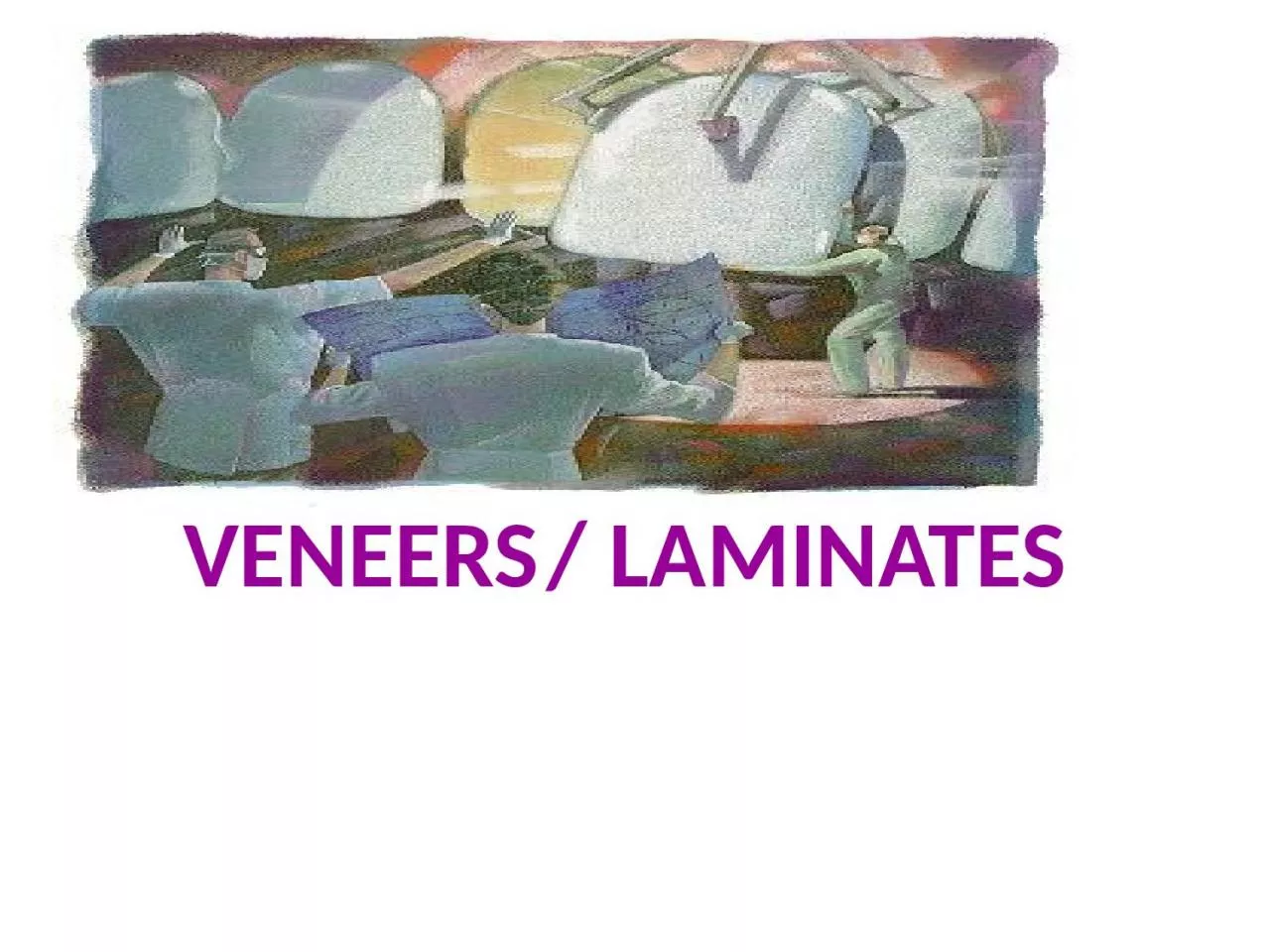

In search of more durable aesthetics VENEERS were introduced Sturdvent DEFINITION Veneer is a layer of tooth colored material that is applied to a tooth to restore a localized or generalized defect and intrinsic discol ID: 1032122
Download Presentation The PPT/PDF document "VENEERS / LAMINATES However, this appr..." is the property of its rightful owner. Permission is granted to download and print the materials on this web site for personal, non-commercial use only, and to display it on your personal computer provided you do not modify the materials and that you retain all copyright notices contained in the materials. By downloading content from our website, you accept the terms of this agreement.
1. VENEERS / LAMINATES
2. However, this approach is undoubtedly most invasive with substantial removal of large amount of tooth substance and possible adverse effects on adjacent pulp and periodontal tissues.In search of more durable aesthetics VENEERS were introduced.
3. SturdventDEFINITIONVeneer is a layer of tooth colored material that is applied to a tooth to restore a localized or generalized defect and intrinsic discoloration
4.
5.
6. Direct techniqueWhen only a few teeth are involved or when the entire facial surface is not faulty (i.e., partial veneers), cases involving young children.Time consuming and labor intensive, sensitive to operator technique.Economical, single sitting procedure Composite Indirect techniqueIf multiple teeth are to be veneered, indirect veneers usually can be placed much more expeditiously.Expensive, requires two appointmentMore aesthetic, less sensitive to operator technique, lasts much longer than direct veneersProcessed composite, feldspathic porcelain, pressed ceramic6
7. 3 BASIC PREPARATION DESIGNS
8.
9. Window Preparation DesignIndicationsAdvantagesRecommended for indirectly fabricated porcelain veneers in patients who exhibit a canine-guided pattern of lateral guidance.Preserves the functional lingual and incisal surfaces of maxillary anterior teeth, protecting the veneers from significant occlusal stress. Reduces the potential for accelerated wear of the opposing tooth
10. ADVANTAGESEstheticsVeneers is more conservative tooth preparationRepair potentialChair side control of the anatomy and easy polishedLow thermal conductivityLess expensiveDISADVANTAGESTend to discolourWear out quicklyMarginal stainingShade matching difficultyOften require repair & replacement
11.
12. ENDONTICALLY TREATED FRACTURED ANTERIOR TEETHIndicationsDIASTEMADISCOLORATION
13. MISSING CENTRAL INCISORWIDE DEFICIENT RESTORATION ON FACIAL SURFACETOOTH BRUSH ABRASION BONDING TO EXISTING RESTORATIONS
14. GENERALIZED ENAMEL HYPOPLASIADENTAL FLUOROSISABRADED INCISAL REGIONS
15. ContraindicationHighly caries index Bruxism
16. INSUFFICIENT FUSIBLE SUBSTRATE EXCESSIVE INTERDENTAL SPACING POOR ORAL HYGIENE EXCESSIVELY ROTATED TOOTH
17. I. Based on the extent of tooth involved, (i) Partial veneers (ii) Full veneers - Window preparation - Butt joint incisal preparation - Incisal lapping preparationII. Based on the type of material employed, (i) Directly applied composite veneer (ii) Processed composite veneer (iii) Feldspathic porcelain veneer (iv) Pressed ceramic veneerIII. Based on the mode of fabrication, (i) Direct veneers - Direct Partial veneer - Direct Full veneer (ii) Indirect veneers - No Prep veneers - Etched Porcelain veneers - Pressed Ceramic Veneers TYPES OF VENEERS17
18. TYPES OF VENEERSBASED ON SURFACE INVOLVEMENTTWO TYPES Accomplished by direct or indirect technique
19. PARTIAL VENEER
20. Full veneer
21. Types of preparation
22. Procedure for Laminate Veneers tooth preparationInvolves the following steps
23. Type I (window preparation)
24. Depiction of enamel thickness on the facial aspect of the toothTHE REDUCTION MUST BE IN :
25. A 016 round bur is placed at the tip of the gingival papilla and cuts the cervical margin in a counterclockwise direction. The bur shaft is held in contact with the facial aspect of the tooth1
26. Using the 016 round bur, the gingival and interproximal margins are placed at the correct depth.2
27. Using the cutter depth wheels bur, make a series of different depths at various locations of the facial profile of the tooth3
28. a 018 tapered diamond bur , the unprepared enamel islands are removed to the level of the horizontal depth cuts. The reduction follows the facial contour of the tooth.4
29. It utilizes minimal tooth preparation mainly confined within enamel. Keeping clear of the gingival margins5
30. Type II(Butt joint preparation)
31. 31 BUTT-JOINT INCISIAL DESIGN
32. In type2 laminate veneers we begin as type I but incisel reduction is involved with a 1.5 to 2 mm (butt joint).1
33. A 2 mm incisal reduction without palatal chamfer [butt joint] is prepared .The arrows show the level of the incisal depth cuts. The distal depth cut is the most gingivally positioned, followed by the mesial and then the center depth cuts.2
34. Reducing the incisel edge with a round or flat tapered ended bur. 3
35. The incisal depth cuts are connected creating a uniform reduction that follows the original curvature of the incisal edge. 4
36. Lateral view of prepared tooth 5
37. Type III (wrap around)
38. 38Incisal-lapping Preparation
39. It restricts angle fractures. When the free edge is not overlaid, the occlusal third of the laminates are very thin ( less than 0.3 mm) and liable to fracture. It enhances esthetic properties of laminates.1
40. Type III preparation includes labial and palatal reduction which is distinguished from Type I & II .2
41. 1 mm incisal reduction with 1 mm height palatal chamfer.3
42. A reduction is reduced with a rounded or flat ended bur. 4
43.
44. PROCEDURE STEPSShade selectionPreliminary tooth modificationTooth preparationProvisional restoration direct method indirect methodLaboratory procedures
45. NO-PREP VENEERS45INDICATIONS
46. 46DISADVANTAGES
47. 47
48. FAILURES
49. 49REPAIR OF VENEERS
50. 50
51. 51
52. Lumineers FeaturesMain feature is they are made of ultra thin thickness.Thickness is 0.2-0.3mm.Placed using either NO PREPARATION or MINIMAL CONTURING TECHNIQUERECENT ADVANCES
53. No need to reduce tooth structure.Allows preservation of natural tooth structure.No anesthesia is required.No teeth sensitivity.Traditional Prep Veneers Contact-lens-thin Lumineers Advantages:
54. Over the years there have been various advancements in laminates and veneers in dentistry
55. CONCLUSION